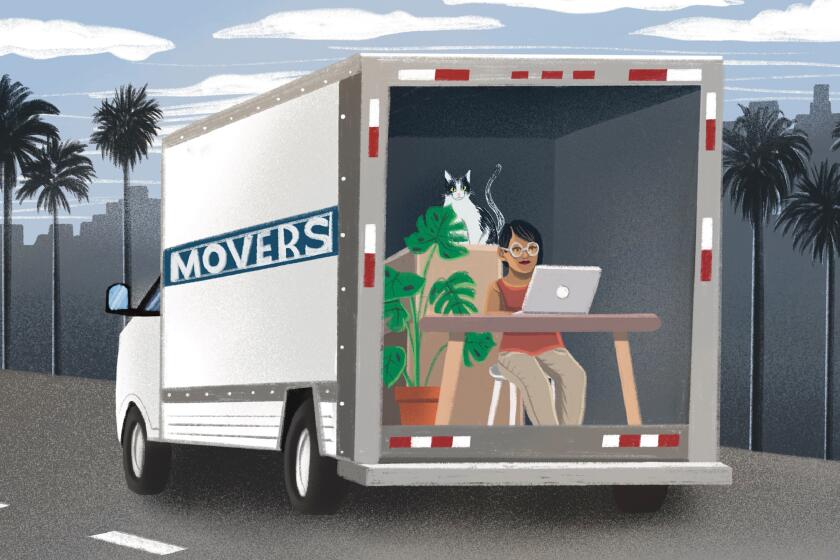How remote working in the post-COVID-19 era could transform L.A. and other cities

- Share via
Formerly bustling office buildings and business districts have felt like ghost towns since the COVID-19 pandemic forced many of us to work remotely. A third of U.S. workers are still working from home, changing the rhythm of life in cities. Rush-hour traffic is lighter, restaurants and shops that cater to office workers remain shuttered, and well-off city-dwellers who no longer need to live near the office are snapping up homes in the suburbs.
The shift to remote work may continue long after the pandemic ends. Tech companies like Twitter and Facebook have announced permanent teleworking options, while Nationwide Insurance, REI and others are closing office buildings in anticipation of new work patterns. More than 80% of office workers would like to work from home at least once a week after the pandemic, and nearly 90% of executives expect many or most of their employees will do so, according to a June survey by consulting firm PwC.
What will Los Angeles and other cities look like when so many more people work from home? Will offices become a thing of the past? Will urban centers be hollowed out? Predictions about the death of the office are premature, but a mass move toward remote work could transform American cities and affect housing prices, traffic and commute times, and where people choose to live.
At USC’s Marshall School of Business, I research how housing and labor markets interact in urban economies, so I was curious what might happen if stay-at-home telecommuting patterns continue long after the pandemic. A recent University of Chicago study found that 37% of jobs in the U.S. can be done entirely from home. With two colleagues, I developed a model to help understand what Los Angeles might look like if a third of employees worked from home.
We found that the population in Los Angeles would spread slightly out from the core to the periphery as teleworking loosens the connection between where we live and where we work. Driven by financial concerns and lifestyle preferences, some new telecommuters would move from the urban core to the suburbs and beyond.
This doesn’t mean city centers will empty out. Millennials and others drawn by amenities like restaurants and the arts may stay put even if they no longer have to, assuming these amenities spring back post-pandemic. And as higher-paid teleworkers move away from central areas, home prices will drop in those locations, making it more affordable for others to move in — especially those who still need to come into the office. This could benefit low-income workers who have been pushed farther into the suburbs by gentrification and currently face grueling commutes.
As a result, urban neighborhoods may become more economically diverse. Gentrification won’t go away, but with less competition for real estate in the urban core, overall housing prices will likely drop citywide. Our analysis of movement within Los Angeles found that overall home prices could decline by around 6%.
However, some full-time teleworkers may leave the city altogether. In a second study, we modeled migration across the country, rather than just within a single urban area. In this case, teleworkers would spread out from larger coastal cities to smaller interior cities, where their housing money would go further.
However, a handful of large cities, including Los Angeles and San Diego, could draw some of the now-untethered telecommuters attracted by the cities’ unique amenities. While home prices in most large cities will drop, costs in the most desirable urban areas may not fall much, because of an influx of new residents.
As people move and real estate prices shift, businesses may also make different decisions about where to locate. Some companies are toying with having smaller satellite offices spread around a city or region rather than a single large headquarters. As land becomes cheaper in city centers, other businesses may choose to move downtown. And as people spread out, there may be fewer mixed commercial and residential districts that often define city living.
Working from home will become the norm for many employees even after the pandemic ends. But prepare for a pay cut.
Those who still have to go to an office will face less-crowded roads, buses and trains, and might be able to afford to live slightly closer to work because of lower housing prices. If a third of people work from home, overall time spent commuting in Los Angeles could drop 32%.
Teleworking has been steadily rising for years as technology has advanced, but the pandemic transformed the landscape overnight. It shifted our understanding of what’s possible and won over many workers and executives who were previously skeptical. Forty-four percent of employers say they feel their employees have been more productive working from home, according to PwC. In addition, companies don’t have to spend significant money on leasing and operating office space.
However, teleworking’s long-range impact on networking, collaboration and other activities that benefit from face-to-face interaction is not yet known. If it ends up dampening productivity in the long run, it could shrink the economy and depress wages, potentially countering the benefits of lower home prices and less traffic.
Some of us will return to the office after the pandemic ends, if we haven’t already. But many will go in fewer days a week, and some won’t return at all. Teleworking is now an accepted part of society’s fabric, reshaping not only how we work but also where we live — and transforming the very city we call home.
Andrii Parkhomenko is an assistant professor of finance and business economics at the USC Marshall School of Business. This article is based on research he conducted with Matt Delventhal, an assistant professor of economics at Claremont McKenna College, and Eunjee Kwon, a graduate student in economics at USC.
More to Read
A cure for the common opinion
Get thought-provoking perspectives with our weekly newsletter.
You may occasionally receive promotional content from the Los Angeles Times.










